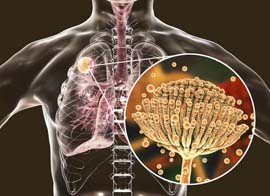
The fungus Aspergillus fumigatus blocks messenger substances in the immune system
Research project shows the nasty methods of Aspergillus fumigatus
Professor Oliver Werz and colleagues at the Friedrich Schiller University found that the fungus Aspergillus fumigatus may be life-threatening for immunocompromised people. In the populated body, this fungal genus releases the poison “gliotoxin”. A specific enzyme in the gliotoxin ensures that the production of the messenger substance LTB4 in the neutrophilic granulocytes is prevented. It is important to know that the neutrophils are the first line of defense of the immune system. As soon as a cell of the healthy immune system comes into contact with a pathogen, it sends leukotrienes (messenger substances) into the blood to attract more helpers. Due to this superior power of immune cells, the body normally succeeds in destroying the invading mold. However, if the communication channels within the immune system are interrupted by the mold poison, then the pathogen can nest freely in tissues and organs and seriously threaten the health.
Evaluation aid for a mold in the room air
For building biologists, the Guideline of the Federal Environmental Agency Germany (UBA 2017) offers important support in the evaluation of indoor air samples. A comparison between outdoor and indoor air indicates whether an indoor source could be present. If the difference in colony-forming units (CFU) in untypical fresh air species such as the Aspergillus species is below 50 CFU per cubic meter room air, this is called a tolerable background load. With a difference between 50 and 100, an indoor source is possible. If there is an indoor result of more than 100 cfu/m³ compared to the outside, then an indoor source is considered probable. The UBA Guide provides further parameters, e.g. a comparison of the CFU of all untypical fresh air species or a comparison of atypical outside air species with poor airborne distribution, such as the Stachybotrys chartarum. The distinction between indoor and outdoor air is applied both to the group of cultivable molds and to the total pore load.
Links
Research project Aspergillus fumigatus
Guideline of the Scientific Medical Societies (only german language)
Find green experts
